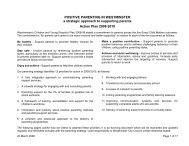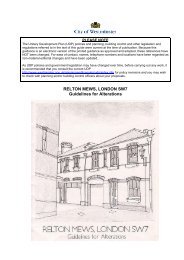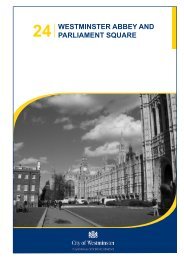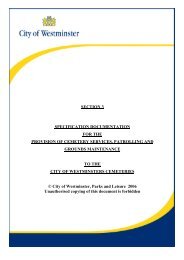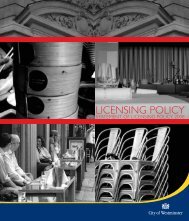Westminster Open Spaces Noise Study 2008 Final Report
Westminster Open Spaces Noise Study 2008 Final Report
Westminster Open Spaces Noise Study 2008 Final Report
- No tags were found...
You also want an ePaper? Increase the reach of your titles
YUMPU automatically turns print PDFs into web optimized ePapers that Google loves.
<strong>Westminster</strong> <strong>Open</strong> <strong>Spaces</strong> <strong>Noise</strong><strong>Study</strong> <strong>2008</strong>: <strong>Final</strong> <strong>Report</strong>3.2.5 Weighting CalculationTotal number of responses for a given Likert value inthe given typologyTotal number of responses for the given typologyX Coding of responseon Likert Scale(See table 4 above)Worked example for Civic Mixed SurfaceSpace (CMSS) which contains 3 sites:(1+4+0)13X 2 = 0.77Where:1 + 4 + 0 = Number of respondents from the 3 sites in this typology who ‘strongly like’ ‘AGreen Landscape’13 = Total number of respondents in the three CMSS sites2 = Code given to the opinion “strongly like3.2.6 The formula is repeated for each Likert value (strong dislike, dislike, neutral, like andstrongly like) for a given experiential factor (e.g. hearing birds, feeling water, seeingcrowds). These values are then added together to produce a weighted tranquillity score foreach of the 60+ experiential factors (see Appendix E).3.3 Use of Weighting3.3.1 At the core of the toolkit method and the division of sites into typologies is theunderstanding that in different types of spaces, i.e. four distinct typologies, the experienceof tranquillity is ‘different’, not ‘more’ or ‘less’. It may therefore be counter-productive to tryand arrive at a single tranquillity score for each typology in order to compare between themand inadvertently rule out a particular type of space, (e.g. Civic Paved <strong>Spaces</strong>) because itscores poorly against other typologies. For example, the qualitative responses in TrafalgarSquare suggested that a user can gain an element of tranquillity, by being a spectator inone of the world’s most famous squares where one can also pause for reflection and watchthe world go by.3.3.2 It is only with the toolkit weighting that comparison between tranquillity scores can be maderegardless of typology. For instance, to make a decision between investment in either SohoSquare (Civic Mixed Surface Space) and Westbourne Gardens (Local Mixed SurfaceSpace), the Council needn’t take into account the qualitative differences in the type ofspace since the Toolkit already addresses those differences by means of the weighting.3.3.3 The weighting attached to each experiential factor also enables the Council to see, at aglance the relative value of each factor within its typology. For example whether seeingbirds contributes more to a sense of tranquillity than seeing trees.D121316/R1/0212Scott Wilson LtdMarch 2009





